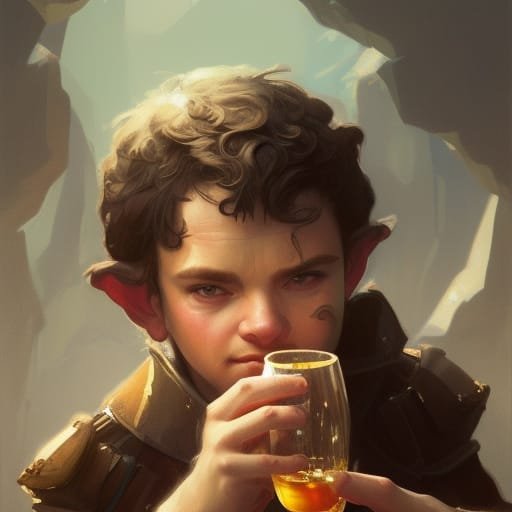Blog
Who is Benzie Fernbottom
Benzie appeared alongside Elina Hogsbreath in A Thyme of Trouble. As Thyme was Elina’s first story, they’ve been a team since the beginning.
I write him as an overly-enthusiastic, young, naive, helpful, yet inadvertently troublemaking sidekick.
A lightfoot, young, fit, and thin - admittedly too thin by halfling standards - Benzie Fernbottom prefers to keep his chestnut-colored hair disheveled and untrimmed, his pointed ears poking out along the sides. He has thick eyebrows, a sharper nose than most, and an eager, wide smile that would give a stranger the impression he was up to something. He wears a white collared, button-up shirt with a handsome brown and green vest and matching pants cut at his knees. And like all halflings, Benzie didn’t wear shoes - he goes through the world barefoot.
Benzie is what I’d refer to as a typical halfling. I see him as good-intentioned and kind but flawed, sometimes going to extremes.
He lives a life of service in the Parishes; he’s happy and comfortable and will never leave.
I use Benzie as a way of expressing typical halfling attitudes and opinions in an environment exposed to outside ideas - the inn, the Swindle & Swine.
He might not appear in every one of Elina’s stories, but I do try to mention him or point out where he may otherwise be.
Author’s Notes: The Keening Cup
On Tuesday, January 3, 2023, I published The Keening Cup to Wattpad.
I wrote this story in response to a Reedsy Writing Prompt:
“Your character always makes the same promise: to change. Will they finally make it happen this time?”
This story takes place in Pondaroak in the Aevalorn Parishes, with Elina Hogsbreath at the Swindle & Swine.
Keening is the act of wailing in grief over a dead person. Wailing women figure prominently in Celtic mythology and certainly have a place in the Swindle.
I borrowed the concept of a banshee - a spirit that heralds the death of a family member - and tied it to a blackthorn wood cup.
Blackthorn trees are common throughout the British Isles and are viewed in Wicca tradition as being a trickster shrub; some Celtic lore assigns negative, sinister properties to the tree. This is the second time I wrote in a blackthorn to symbolize a sinister space or item; the first time was in The Murkwode Reaving.
I introduced a vain, attention-grubbing halfling, Horwich Cobbleberry, who uses a cursed cup to garner attention from fellow townsfolk. Horwich (Horry, he’s an attention whore, get it?), promises Elina every year that he’ll stop using the cup, and it’s a promise that he makes every year.
Horwich isn’t too difficult to imagine as an individual. People who brashly tempt fate, thinking they’ll never be harmed? Or without the foresight to see how others might be harmed by their own actions? Horwich isn’t too complicated and is probably someone we’d find in a bar on New Year’s Eve.
A part of the story is the idea of New Year celebrations. What if you could know if you were to die in the next year? Would you want to know? Would you dare to know? That’s kind of the crux of the story, where Horry is playing a double-dog dare every year.
The story’s theme is about irrational brashness that can lead to despair. Why do we tempt fate? Why do we risk knowing something we’d be better off not knowing? What’s the allure of celebrating people who are reckless with our own safety? Like, stepping into a car knowing the guy driving is intoxicated. Why do we encourage it, and why are we so accepting of their risk?
I start the story at the ending, where Elina’s digging a hole to bury the cursed cup. I thought that would make a good wrap on the story after I sent Horwich bounding into the forest.
When Elina enters her kitchen, she reviews a list of hallucinogenic herbs and psychoactive plants (belladonna, mandrake, sumac, poke root), and the astute reader gets the impression that she’s preparing reagents to create a hallucinatory effect. One of my advance readers actually burst out loud laughing after reading what I was up to in the story.
So Elina appears to be sabotaging Cobbleberry’s big moment, but she’s not sociopathic. Hopefully, I project to the reader that she’s just kind of done with the promises and wants to end the cup’s influence in her inn, once and for all. She doesn’t want to hurt Horwich, but he’s got to be taught a lesson so the yearly ritual can be brought to an end.
In my attempt to show Elina really cares about him, she reminds Horwich where to find a bullaun and to help himself. In another Celtic tradition, a bullaun is a cure or curse stone where its waters are magical.
So, is the Keening Cup really enchanted? What the banshee real or just a hallucination? I think that’s part of the story's charm where I really don’t need to say - the reader can make up their own mind.
I’ll tell you the idea of a cursed cup buried out back the Swindle & Swine is very appealing. I wonder what else is buried out there? Sounds like the stuff of a new story.
As always, thanks for reading, and thanks for sticking around. :)
R








